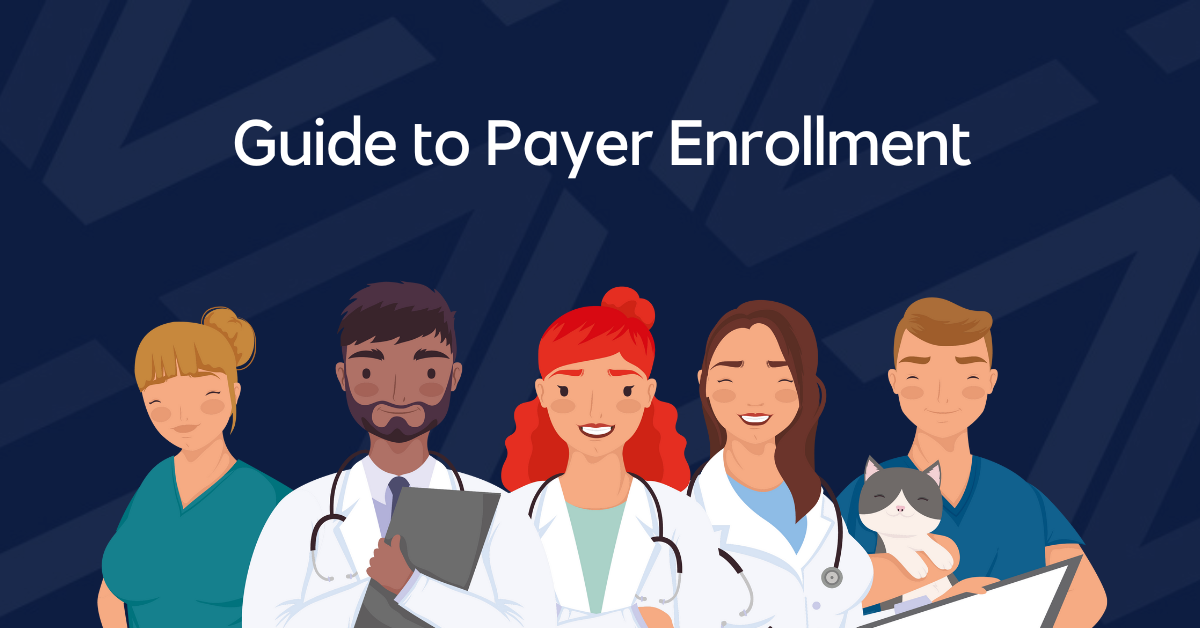
Payer enrollment, also known as healthcare provider enrollment, is the process by which healthcare providers apply to become recognized and approved by health insurance companies (payers) to provide services to insured patients.
Without proper enrollment, healthcare providers cannot receive reimbursement for their services from the insurance companies. This process involves submitting various credentials and documentation to prove the provider’s qualifications and compliance with payer standards.
Healthcare providers must undergo this enrollment process to ensure they can participate in insurance networks, which is crucial for both the providers and the patients they serve. Proper enrollment not only ensures that providers are compensated for their services but also that patients have access to a network of approved and trusted healthcare professionals.
In this post, we provide a comprehensive guide to the payer enrollment process for healthcare organizations and providers.
Why Is Payer Enrollment Important?
Payer enrollment is important for several reasons. First, it allows healthcare providers to receive payment for the services they offer to patients. Without proper enrollment, providers cannot bill insurance companies, which leads to revenue loss.
Additionally, payer enrollment ensures that patients can access care from their preferred providers without facing out-of-network charges, which can be financially burdensome and discourage payment.
Payer enrollment also strengthens the credibility and reputation of healthcare providers. Being part of a network approved by major insurance companies can attract more patients and build trust within the community. It also ensures compliance with regulations and standards set by the payers, which can improve the overall quality of care provided.
Steps in the Payer Enrollment Process
We’ve outlined five major steps in the payer enrollment process below.
Step 1: Gather Required Documentation
Before you begin the payer enrollment process, you need to gather all necessary documentation. This typically includes:
-
State medical license
-
DEA certificate
-
Malpractice insurance
-
Hospital privileges
-
Resume / CV
-
Board certification
Having these documents ready will help streamline the enrollment process. It’s also advisable to keep electronic copies of these documents to facilitate easier submission and record-keeping.
In addition to these standard documents, some payers may require additional information such as proof of continuing education, specialty certifications, or letters of recommendation from other healthcare providers. Ensuring that all documentation is current and accurate will prevent delays in the enrollment process.
Step 2: Identify the Payers
Next, identify which insurance companies you want to enroll with. Consider the patient population you serve and the most common insurance plans in your area. You may want to enroll with major national insurers as well as local or regional payers.
Researching the market and understanding the insurance preferences of your patient demographic can guide you in selecting the right payers. It can also be beneficial to consult with other healthcare providers in your area to understand which payers are most reliable and offer the best reimbursement rates.
Step 3: Complete the Application
Once you’ve identified the payers, you will need to complete their specific enrollment applications. Each payer may have a different application process, so it’s important to carefully follow the instructions provided by each insurance company. This step often involves filling out detailed forms and providing extensive information about your practice.
Pay close attention to each section of the application to ensure accuracy. Errors or omissions can lead to delays or denials. If possible, designate a staff member or hire a professional to review your applications before submission to catch any potential issues.
Step 4: Submit Applications
After completing the applications, you need to submit them along with the required documentation. Some payers may accept electronic submissions, while others may require paper applications. Make sure to keep copies of everything you submit for your records.
It’s beneficial to confirm receipt of your application with the payer to ensure it has been received and is being processed. Consider sending applications via certified mail or another trackable method if submitting paper forms to ensure they reach their destination.
Step 5: Follow Up
Payer enrollment can take several weeks to several months. During this time, it’s important to follow up with the insurance companies to ensure your application is being processed. Be prepared to provide additional information if requested. Regular follow-ups can help expedite the process and keep you informed about any potential issues.
Consider setting a schedule for follow-ups and documenting each interaction with the payer. This can help you track the status of your application and provide a record in case of any disputes or delays.

Common Challenges in Payer Enrollment
Incomplete or Incorrect Applications
One of the most common challenges in payer enrollment is submitting incomplete or incorrect applications. This can lead to delays or even denials. To avoid this, double-check all information and make sure all required documents are included.
It’s also helpful to have a second pair of eyes review the application. Having a colleague or hiring a professional service to check your application can catch errors that you might overlook.
Long Processing Times
Payer enrollment can be a lengthy process, often taking several months. To minimize delays, submit your applications as early as possible and follow up regularly with the insurance companies. Understanding the typical processing times for different payers can help you plan and set realistic expectations.
In some cases, you may be able to expedite the process by providing additional documentation or clarification upfront. Staying proactive and organized can significantly reduce the wait time.
Keeping Track of Multiple Applications
Managing multiple payer enrollments can be overwhelming. Implementing a systematic approach to track deadlines, follow-up dates, and documentation requirements can also help keep the process organized. Maintaining a centralized database or spreadsheet can be another effective way to manage multiple applications.
Benefits of Payer Enrollment Services
Payer enrollment services can simplify the enrollment process for healthcare organizations. These services typically offer:
-
Assistance with completing and submitting applications
-
Tracking the status of applications
-
Handling follow-ups with insurance companies
-
Ensuring compliance with payer requirements
Using payer enrollment services can save time and reduce the risk of errors, allowing healthcare providers to focus on patient care. These services often have established relationships with insurance companies, which can expedite the enrollment process and resolve issues more efficiently.
Additionally, payer enrollment services can provide valuable insights and advice based on their experience with various insurers. This expertise can help you navigate complex requirements and avoid common pitfalls.
Maintaining Your Enrollment Status
Once you are enrolled with payers, it’s important to maintain your enrollment status. This includes:
Updating Information
Keep your information up to date with the insurance companies. This includes changes to your address, contact information, or practice details. Regularly reviewing and updating this information ensures that you remain in compliance and avoid any disruptions in your reimbursement.
Promptly reporting changes to your practice, such as adding new providers or changing office locations, can prevent issues with claims processing and ensure that patients continue to have access to your services without interruption.
Recredentialing
Most payers require recredentialing every few years. This process involves verifying your credentials and ensuring you continue to meet the payer’s requirements. Stay on top of recredentialing deadlines to avoid disruptions in reimbursement.
Keeping a calendar of recredentialing dates and setting reminders can help you stay ahead of deadlines. Having a dedicated staff member manage this process can ensure that all necessary documentation is submitted in a timely manner.
Monitoring Compliance
Monitor and maintain compliance with all payer policies and requirements. This includes staying current with continuing education and maintaining necessary certifications. Regularly reviewing payer guidelines and updates can help you stay informed and compliant.
Consider conducting periodic audits of your practice to ensure all compliance standards are met. This proactive approach can identify potential issues before they affect your enrollment status or reimbursement.
Conclusion
Payer enrollment is a critical step for healthcare organizations to ensure they can receive reimbursement for their services. By understanding the enrollment process, gathering the necessary documentation, and staying on top of application statuses, healthcare providers can successfully navigate payer enrollment. Utilizing payer enrollment services can further simplify the process and help manage the complexities involved.
With proper payer enrollment, healthcare organizations can focus on providing high-quality care to their patients without worrying about reimbursement issues.
Use these practical tips to streamline your payer enrollment process and set your healthcare organization up for success.